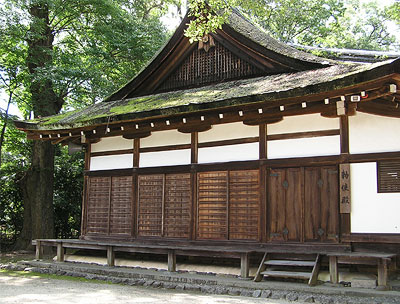| The chokushiden is the place where an envoy,
chokushi Ίg, stays when he is sent to a shrine to offer oblations to the
gods on behalf of the Emperor. The chokushiden at Nanguu Jinja μ{_Π (1642)
in Gifu prefecture, is 3 ~ 4 bays with steps leading to the main entrance. Sliding
doors are placed in each side bay, but the middle bay is open. This 3~1 area is
called the *gomadou μ°.
Opposite the open entrance to the gomadou is a center entrance with double
doors opening into the chokushiden which is 3~3 bays. Another entrance
is in the center bay on the right side when facing the gomadou. A veranda
surrounds the building. Sometimes the *shinpukuden
_a, a room normally used for making summer and winter clothing for the gods,
is used as quarters for the envoy's stay. Example: the two side by side rooms
at Kamo Mioya Jinja κΞδc_Π (1863) in Kyoto, each of which are three bays wide
and two bays deep with gabled roofs *kirizuma-zukuri
ΨΘ’, covered with cypress bark *hiwadabuki
Oη. These characteristics do not reflect a set arrangement for such buildings.
On the contrary, there is considerable variation in size and treatment of shrine
buildings. |



